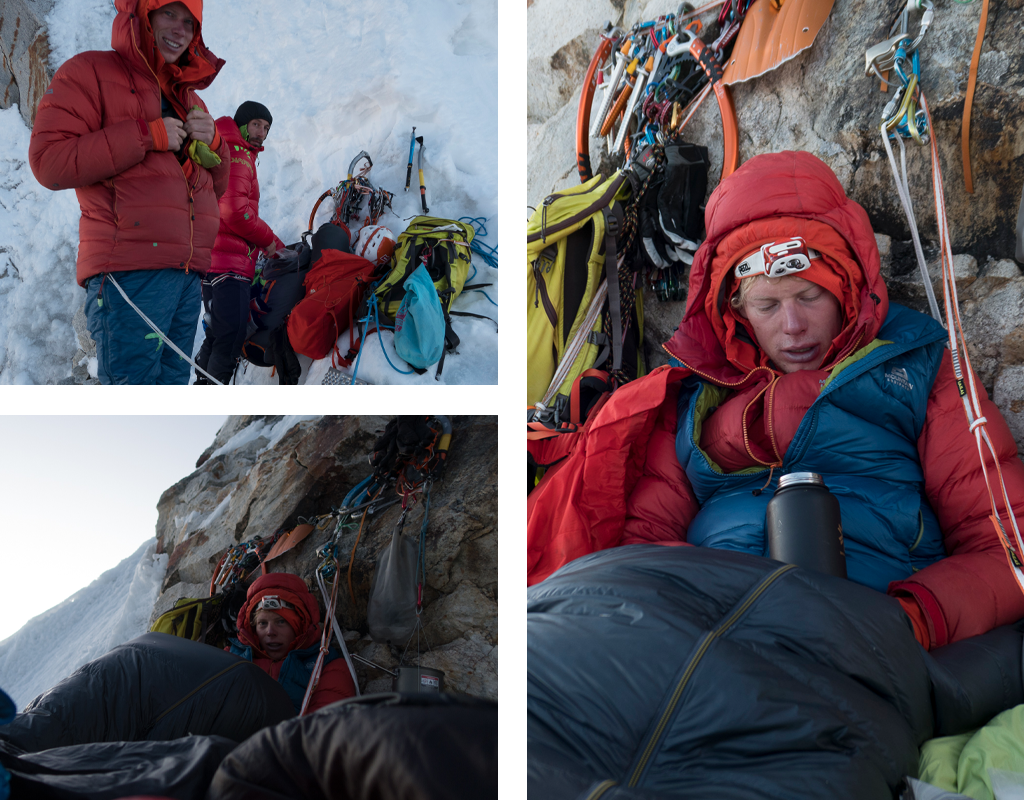Top Bivvy Tips | Tom Livingstone & Uisdean Hawthorn
- Kit Lists and Guides

Bivvying in the mountains is a tale of two. You could have one of the best experiences, comfortable and safe under star-filled skies, or the polar-opposite; confronted with spindrift throughout a sleepless night. Before you head off on your next alpine route, here are some top bivvy tips from Tom Livingstone and Uisdean Hawthorn to help you make your next bivvy a comfortable and considered one.

Words by Tom Livingstone & Uisdean Hawthorn
________
Bivying in the mountains seems to range from a relatively short and comfortable night, to a sleepless suffer-fest. Of course, the first rule is: don’t bivvy! Avoid stopping in the mountains if at all possible – it’s inefficient and much more fun to climb with a lighter pack.
But some big alpine routes will naturally take more time; and if you’re climbing new ground, you won’t know what lies ahead. You don’t want to have to bail because you’ve ran out of time/energy, so bivvying will allow you to continue for much longer than single-push tactics.

5 Tips for the Perfect Bivvy
1. The thought of the night is worse than its bite
Usually, bivvies aren’t as bad as you think. You’ll be surprised at what you can cope with. No sleeping bag or mat? Dropped your warm jacket? It’ll probably be alright. Eventually, the grey light of dawn will come, and with it… relief. The thought of night is usually worse than the night itself.
2. Match kit to conditions
Try to judge the weather, conditions and route, then pick an insulation and mat combination. Summer in Patagonia? A warm jacket and sitting on your ropes should be enough. Winter in the Alps? A thin sleeping bag and the padding of your rucksack could suffice. I usually take ‘the suffer pad:’ a tiny piece of foam which can be clipped to the belay, and then put my feet in my pack. I’ll complement it with a thin sleeping bag (e.g. Mountain Equipment Fireflash or Firefly) in winter. A hanging kit for your stove ensures you won’t drop it.
3. Attitude adjustment
The experience can either be pleasant or a suffer-fest, and it usually depends on your attitude. Embrace it, enjoy the views and don’t try to sleep. Rumour has it that Pete Graham actually enjoys bivvies!
4. Light is right
Light is right in alpinism, and big weight savings can be made with your bivvy system. Get the lightest, best-performing kit; test it and then make experience-based decisions. Shave grams by taking the most sensible and lightest insulation/mat combination you know you can use. In some cases, a single-skin tent is the warmest and lightest system.
5. Don't Bivi!
The best bivvies are spent in a warm hut or in your own bed. Get fitter, climb efficiently and don’t bivvy!

Tips for the Most Comfortable Bivvy
• Choose the location carefully. Ideally find a flat ledge which is protected from anything which might fall from above, and is sheltered from the wind.
• Flatten out the area (make it much bigger than you think) and use rocks/snow/ice/rucksacks/snow hammock to enlarge the area if necessary.
• Build a solid anchor above you, so you can clip into it, clip in all your gear, and hang the stove on it. Get an MSR Reactor stove.
• Get a hanging kit for the stove.
• Bring an iPod Shuffle; the tunes will help you sleep/wake up.
• Bring spare socks. Dry the damp ones down your chest.
• Loosen your boots and keep wiggling your toes.
• Put Mountain Equipment Citadel Mitts on your feet.
• Hot hands sachets are great!
• If you’ve got a warm jacket, take a slightly less-than-warm sleeping bag.

Tom Livingstone's Best Bivvies
1. 3rd bivvy on the North Ridge Variation of Latok I (7145m), with Ales Cesen and Luka Strazar. We finally managed to get the tent up at this snowy platform, and used the custom double sleeping bag to get a decent night’s sleep.
2. The bivvy on the House/Anderson route, Mt. Alberta, Canadian Rockies, with Uisdean Hawthorn. There’s a natural limestone cave/tunnel halfway up the mountain, where you can walk around and take your harness off!
3. 2nd bivvy on a winter ascent of the Walker Spur, Grandes Jorasses, with Pete Graham. This was a sitting bivvy (like all the best/worst bivvies!) and fun – in hindsight.
Tom Livingstone's Worst Bivvy
“Acclimatising” by sleeping at 17,000ft camp on Denali, with Uisdean Hawthorn. I barely slept, and it was bloody freezing! I think -38ºC was being suggested…
Uisdean Hawthorne's Top Bivvy
3rd Bivi on the first ascent of Gandiva on Arjuna (6100m) in the Indian Himalaya. The bivi was in this sitting scoop with our legs sticking out over the edge. Pete Graham, Ben Silvestre and I slept quite well mainly because we were fairly knackered by this point. But the reason it was so good was the sunrise lighting up Brammah II an image that will stay in my head forever.
Uisdean Hawthorne's Worst Bivvy
After the climbing the American Direct in a day Tom Livingstone and I got to the Charpoua glacier at 3am. We started climbing at 3am the day before and hadn’t stopped once. We couldn’t find our way through the crevasses and had to sleep on a rock with no bivvy kit, and wait for it to get light again. Once it got light, we weaved our way through the crevasses and reached the Charpua hut in under 20 minutes. I have had longer and colder bivvies, but the knowing that a warm hut was so close whilst shivering with cramping muscle was hard to take.
Just remember: it’s not as bad as you think! The night will end. But a good bivy will mean you’re psyched to go up in the morning; a bad one will make you look at the ground.





